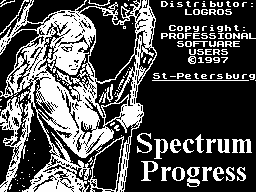|
Spectrum Progress #02
19 января 1997 |
|
Entries programmer - the musical programming of the processor AY-8912/10.

(C) Dennis Parinov, 1997.
Music processor includes 16 registers. 14 were used to
generate sound.
In order to put in the register of musical coprocessor are
any data, you must:
1) Select a register to record data
LD BC, # FFFD
LD A, the register number 0 - 13
OUT (C), A
2) write data
LD BC, # BFFD
LD A, kakoe any number 0 - 255
OUT (C), A
To read the data from the register must:
1) Select a register to record data
LD BC, # FFFD
LD A, the register number 0 - 13
OUT (C), A
2) read data
IN A, (C)
The first six registers are used to
set the pitch of each channel of
range 0 - 4095.
Registers R0, R1 - frequency sound channel A.
Registers R2, R3 - frequency sound channel B.
Registers R4, R5 - frequency sound channel C.
Register R6 - determines the frequency output
noise for the three channels from a range of 0 - 31.
Register R7 - controls audio channels
d7d6d5d4d3d2d1d0
xx prohibits the sounding channel A.
prohibits the sounding of the channel B.
prohibits the sounding of the channel C.
prohibits noise channel A.
prohibits noise channel B.
prohibits noise channel C.
The following three registers are used to
set the volume in the range 0 - 15.
4-th bit indicates that the volume will be
changing the way specified in R13 and with
speed indications in R11/R12.
Register R8 - determines the volume of channel A.
Register R9 - determines the volume of channel B.
Register R10 - determines the volume of the channel C.
Registers R11, R12 - determine the rate of
change the volume from 0 to 65535. (On
Practice change reg. R11 malooschutimo,
so it suffices to specify only reg. R12)
Register R13 - uprovlyaet formation
envelope of output signal:
# 0, # 1, # 2, # 3, # 9 - fading, then quietly;
# 4, # 5, # 6, # 7, # F - growth, then quietly;
# B - decay, then loudly;
# D - the increase, then zromko;
# 8 - recurring decay;
# C - repeated growth;
# E - repeated growth and
damping;
# A - recurring decay and
growth;
And now a few examples demonstrating the legend.
Before applying to the program in the register A
need to record the effect of number from 1 to 4.
, BT: A - number of effect from 1 - 4.
AY_EFF LD HL, EFFECT1; Calculate
LD BC, # 000E; starting address
NEFF ADD HL, BC; effect next
DEC A; for selected.
JP NZ, NEFF;
DEC HL; HL at the end of the chosen
; Nnogo effect.
LD A, # 0D; Start with reg-ra R13
LD C, # FD;
NREG LD B, # FF; Select Registry AY
OUT (C), A; for recording data.
LD B, # BF; entry in the register AY
OUTD; bytes of (HL) and
, A reduction in HL 1.
DEC A; Reduced rates
; Register AY, if
JP P, NREG; he Є 0, continue.
RET; Otherwise exit.
; Effect is used in various boot'ah at
; Startup programs.
EFFECT1 DEFW # 0080, # 0001, # 0000; tone frequency
; For channels A, B, C
DEFB # 00; frequency noise
DEFB # 38; 00111000 Off. noise.
DEFB # 10, # 10, # 10; loudly. channel. A, B, C
DEFW # 1500; volume change
DEFB # 01; damping
, The effect of the program Honey Commander.
EFFECT2 DEFW # 203C, # 2064, # 208C
DEFB # 00
DEFB # 38
DEFB # 10, # 10, # 10
DEFW # 0810
DEFB # 01
; Effect 2 of Honey Commander.
EFFECT3 DEFW # 2050, # 2060, # 2070
DEFB # 01
DEFB # 00
DEFB # 10, # 10, # 10
DEFW # 0400
DEFB # 01
; Effect reminiscent of rotation of the blades
; Helicopter.
EFFECT4 DEFW # 0000, # 0000, # 0000
DEFB # 00
DEFB # 07
DEFB # 10, # 10, # 10
DEFW # 0100
DEFB # 0E
In conclusion, about one bad moment.
Sometimes when reading from the disk from the speakers is heard
buzz - this is due to the fact that the programmer does not
choke muz.protsessor. Usually, do this again to initialize the
player tunes.
In any case, we present a program stifles muz.protsessor.
RES_AY LD HL, # 0D00
LD DE, # FFBF
LD C, # FD
RES_AY1 LD B, D
OUT (C), H
LD B, E
OUT (C), L
DEC H
JP P, RES_AY1
RET
*
Other articles:
Similar articles:
В этот день... 29 December